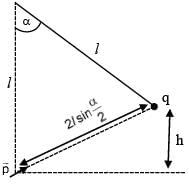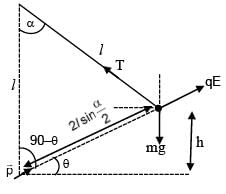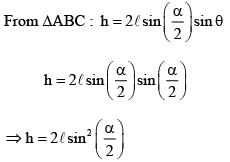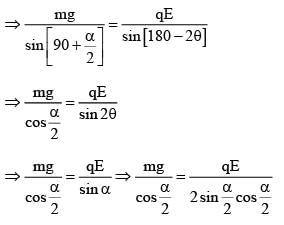JEE Exam > JEE Questions > A point charge q of mass m is suspended verti...
Start Learning for Free
A point charge q of mass m is suspended vertically by a string of length l. A point dipole of dipole moment  is now brought towards q from infinity so that the charge moves away. The final equilibrium position of the system including the direction of the dipole, the angles and distances is shown in the figure below. If the work done in bringing the dipole to this position is N×(mgh), where g is the acceleration due to gravity, then the value of N is _________ . (Note that for three coplanar forces keeping a point mass in equilibrium, F/sinθ is the same for all forces, where F is any one of the forces and θ is the angle between the other two forces)
is now brought towards q from infinity so that the charge moves away. The final equilibrium position of the system including the direction of the dipole, the angles and distances is shown in the figure below. If the work done in bringing the dipole to this position is N×(mgh), where g is the acceleration due to gravity, then the value of N is _________ . (Note that for three coplanar forces keeping a point mass in equilibrium, F/sinθ is the same for all forces, where F is any one of the forces and θ is the angle between the other two forces)

 is now brought towards q from infinity so that the charge moves away. The final equilibrium position of the system including the direction of the dipole, the angles and distances is shown in the figure below. If the work done in bringing the dipole to this position is N×(mgh), where g is the acceleration due to gravity, then the value of N is _________ . (Note that for three coplanar forces keeping a point mass in equilibrium, F/sinθ is the same for all forces, where F is any one of the forces and θ is the angle between the other two forces)
is now brought towards q from infinity so that the charge moves away. The final equilibrium position of the system including the direction of the dipole, the angles and distances is shown in the figure below. If the work done in bringing the dipole to this position is N×(mgh), where g is the acceleration due to gravity, then the value of N is _________ . (Note that for three coplanar forces keeping a point mass in equilibrium, F/sinθ is the same for all forces, where F is any one of the forces and θ is the angle between the other two forces)
Correct answer is '2'. Can you explain this answer?
Most Upvoted Answer
A point charge q of mass m is suspended vertically by a string of leng...


Now, from ΔOAB
α + 90 - θ + 90 - θ = 180
⇒ α = 2θ

Now charge is in equilibrium at point B.
So, using sine rule


α + 90 - θ + 90 - θ = 180
⇒ α = 2θ

Now charge is in equilibrium at point B.
So, using sine rule



⇒ substituting this in equation (i)

⇒ Uf = 2mgh
W = ΔU = Nmgh = N = 2
Free Test
FREE
| Start Free Test |
Community Answer
A point charge q of mass m is suspended vertically by a string of leng...


Now, from ΔOAB
α + 90 - θ + 90 - θ = 180
⇒ α = 2θ

Now charge is in equilibrium at point B.
So, using sine rule


α + 90 - θ + 90 - θ = 180
⇒ α = 2θ

Now charge is in equilibrium at point B.
So, using sine rule



⇒ substituting this in equation (i)

⇒ Uf = 2mgh
W = ΔU = Nmgh = N = 2

|
Explore Courses for JEE exam
|

|
Similar JEE Doubts
A point charge q of mass m is suspended vertically by a string of length l. A point dipole of dipole moment is now brought towards q from infinity so that the charge moves away. The final equilibrium position of the system including the direction of the dipole, the angles and distances is shown in the figure below. If the work done in bringing the dipole to this position is N×(mgh), where g is the acceleration due to gravity, then the value of N is _________ . (Note that for three coplanar forces keeping a point mass in equilibrium, F/sinθis the same for all forces, where F is anyone of the forces and θ is the angle between the other two forces)Correct answer is '2'. Can you explain this answer?
Question Description
A point charge q of mass m is suspended vertically by a string of length l. A point dipole of dipole moment is now brought towards q from infinity so that the charge moves away. The final equilibrium position of the system including the direction of the dipole, the angles and distances is shown in the figure below. If the work done in bringing the dipole to this position is N×(mgh), where g is the acceleration due to gravity, then the value of N is _________ . (Note that for three coplanar forces keeping a point mass in equilibrium, F/sinθis the same for all forces, where F is anyone of the forces and θ is the angle between the other two forces)Correct answer is '2'. Can you explain this answer? for JEE 2025 is part of JEE preparation. The Question and answers have been prepared according to the JEE exam syllabus. Information about A point charge q of mass m is suspended vertically by a string of length l. A point dipole of dipole moment is now brought towards q from infinity so that the charge moves away. The final equilibrium position of the system including the direction of the dipole, the angles and distances is shown in the figure below. If the work done in bringing the dipole to this position is N×(mgh), where g is the acceleration due to gravity, then the value of N is _________ . (Note that for three coplanar forces keeping a point mass in equilibrium, F/sinθis the same for all forces, where F is anyone of the forces and θ is the angle between the other two forces)Correct answer is '2'. Can you explain this answer? covers all topics & solutions for JEE 2025 Exam. Find important definitions, questions, meanings, examples, exercises and tests below for A point charge q of mass m is suspended vertically by a string of length l. A point dipole of dipole moment is now brought towards q from infinity so that the charge moves away. The final equilibrium position of the system including the direction of the dipole, the angles and distances is shown in the figure below. If the work done in bringing the dipole to this position is N×(mgh), where g is the acceleration due to gravity, then the value of N is _________ . (Note that for three coplanar forces keeping a point mass in equilibrium, F/sinθis the same for all forces, where F is anyone of the forces and θ is the angle between the other two forces)Correct answer is '2'. Can you explain this answer?.
A point charge q of mass m is suspended vertically by a string of length l. A point dipole of dipole moment is now brought towards q from infinity so that the charge moves away. The final equilibrium position of the system including the direction of the dipole, the angles and distances is shown in the figure below. If the work done in bringing the dipole to this position is N×(mgh), where g is the acceleration due to gravity, then the value of N is _________ . (Note that for three coplanar forces keeping a point mass in equilibrium, F/sinθis the same for all forces, where F is anyone of the forces and θ is the angle between the other two forces)Correct answer is '2'. Can you explain this answer? for JEE 2025 is part of JEE preparation. The Question and answers have been prepared according to the JEE exam syllabus. Information about A point charge q of mass m is suspended vertically by a string of length l. A point dipole of dipole moment is now brought towards q from infinity so that the charge moves away. The final equilibrium position of the system including the direction of the dipole, the angles and distances is shown in the figure below. If the work done in bringing the dipole to this position is N×(mgh), where g is the acceleration due to gravity, then the value of N is _________ . (Note that for three coplanar forces keeping a point mass in equilibrium, F/sinθis the same for all forces, where F is anyone of the forces and θ is the angle between the other two forces)Correct answer is '2'. Can you explain this answer? covers all topics & solutions for JEE 2025 Exam. Find important definitions, questions, meanings, examples, exercises and tests below for A point charge q of mass m is suspended vertically by a string of length l. A point dipole of dipole moment is now brought towards q from infinity so that the charge moves away. The final equilibrium position of the system including the direction of the dipole, the angles and distances is shown in the figure below. If the work done in bringing the dipole to this position is N×(mgh), where g is the acceleration due to gravity, then the value of N is _________ . (Note that for three coplanar forces keeping a point mass in equilibrium, F/sinθis the same for all forces, where F is anyone of the forces and θ is the angle between the other two forces)Correct answer is '2'. Can you explain this answer?.
Solutions for A point charge q of mass m is suspended vertically by a string of length l. A point dipole of dipole moment is now brought towards q from infinity so that the charge moves away. The final equilibrium position of the system including the direction of the dipole, the angles and distances is shown in the figure below. If the work done in bringing the dipole to this position is N×(mgh), where g is the acceleration due to gravity, then the value of N is _________ . (Note that for three coplanar forces keeping a point mass in equilibrium, F/sinθis the same for all forces, where F is anyone of the forces and θ is the angle between the other two forces)Correct answer is '2'. Can you explain this answer? in English & in Hindi are available as part of our courses for JEE.
Download more important topics, notes, lectures and mock test series for JEE Exam by signing up for free.
Here you can find the meaning of A point charge q of mass m is suspended vertically by a string of length l. A point dipole of dipole moment is now brought towards q from infinity so that the charge moves away. The final equilibrium position of the system including the direction of the dipole, the angles and distances is shown in the figure below. If the work done in bringing the dipole to this position is N×(mgh), where g is the acceleration due to gravity, then the value of N is _________ . (Note that for three coplanar forces keeping a point mass in equilibrium, F/sinθis the same for all forces, where F is anyone of the forces and θ is the angle between the other two forces)Correct answer is '2'. Can you explain this answer? defined & explained in the simplest way possible. Besides giving the explanation of
A point charge q of mass m is suspended vertically by a string of length l. A point dipole of dipole moment is now brought towards q from infinity so that the charge moves away. The final equilibrium position of the system including the direction of the dipole, the angles and distances is shown in the figure below. If the work done in bringing the dipole to this position is N×(mgh), where g is the acceleration due to gravity, then the value of N is _________ . (Note that for three coplanar forces keeping a point mass in equilibrium, F/sinθis the same for all forces, where F is anyone of the forces and θ is the angle between the other two forces)Correct answer is '2'. Can you explain this answer?, a detailed solution for A point charge q of mass m is suspended vertically by a string of length l. A point dipole of dipole moment is now brought towards q from infinity so that the charge moves away. The final equilibrium position of the system including the direction of the dipole, the angles and distances is shown in the figure below. If the work done in bringing the dipole to this position is N×(mgh), where g is the acceleration due to gravity, then the value of N is _________ . (Note that for three coplanar forces keeping a point mass in equilibrium, F/sinθis the same for all forces, where F is anyone of the forces and θ is the angle between the other two forces)Correct answer is '2'. Can you explain this answer? has been provided alongside types of A point charge q of mass m is suspended vertically by a string of length l. A point dipole of dipole moment is now brought towards q from infinity so that the charge moves away. The final equilibrium position of the system including the direction of the dipole, the angles and distances is shown in the figure below. If the work done in bringing the dipole to this position is N×(mgh), where g is the acceleration due to gravity, then the value of N is _________ . (Note that for three coplanar forces keeping a point mass in equilibrium, F/sinθis the same for all forces, where F is anyone of the forces and θ is the angle between the other two forces)Correct answer is '2'. Can you explain this answer? theory, EduRev gives you an
ample number of questions to practice A point charge q of mass m is suspended vertically by a string of length l. A point dipole of dipole moment is now brought towards q from infinity so that the charge moves away. The final equilibrium position of the system including the direction of the dipole, the angles and distances is shown in the figure below. If the work done in bringing the dipole to this position is N×(mgh), where g is the acceleration due to gravity, then the value of N is _________ . (Note that for three coplanar forces keeping a point mass in equilibrium, F/sinθis the same for all forces, where F is anyone of the forces and θ is the angle between the other two forces)Correct answer is '2'. Can you explain this answer? tests, examples and also practice JEE tests.

|
Explore Courses for JEE exam
|

|
Signup to solve all Doubts
Signup to see your scores go up within 7 days! Learn & Practice with 1000+ FREE Notes, Videos & Tests.



























